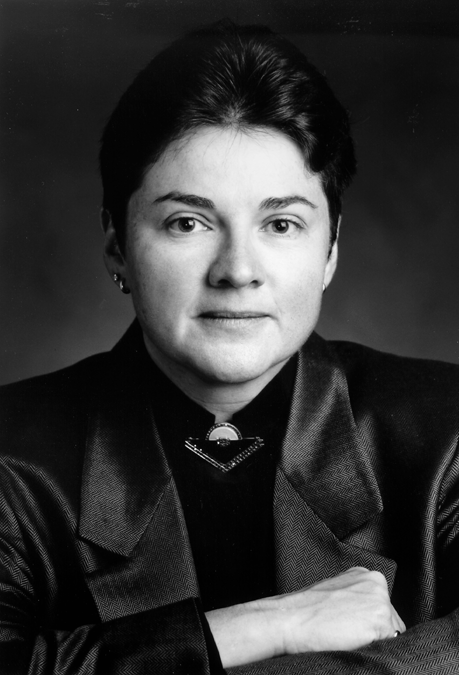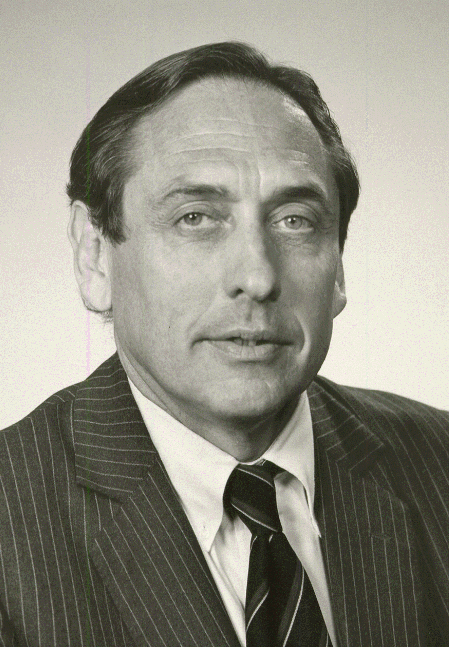
 |
|
|

Sara S. Foland. Photo by Paul Abdoo. |
SARA S. FOLAND, former CEO and president of Farallon
Energy Group Ltd. in Denver, became CEO of the Geological
Society of America (GSA) on June 30. She succeeds Donald M. Davidson
Jr., who retired.
Foland says that one goal for GSA is “to begin looking at strategic relationships with sister societies and to meet GSA’s objectives of science education.” She wants to expand GSA’s role in the geoscience community through new partnerships to prepare the society for future demands. Specifically, Foland would like to utilize the knowledge members have in applied research and help GSA meet the needs of student members. While at Farallon Energy Group, Foland built an organization and investment
portfolio for acquiring gas-producing properties throughout the United
States. She also held leadership and geotechnical positions at Amoco Production
Co. in Denver. She holds an Executive MBA from Indiana University and a
master’s degree in geology from the University of Montana and will finish
her Ph.d. in tectonics at the University of California-Santa Cruz next
year. She also belongs to the American Association of Petroleum Geologists,
American Geophysical Union, Society of Exploration Geophysicists, Rocky
Mountain Association of Geologists, Sigma Xi, and American Association
of University Women.
|
| M. Ray Thomasson, of Thomasson Partner Associates
Inc., is the 1999–2000 president of the American
Association of Petroleum Geologists.
AAPG is actively seeking to be a more effective partner with its members, expand cooperation with its sister societies, promote K–12 education, and communicate to political leaders the enormous oil, gas, and coal resource base remaining in this country, Thomasson says. Thomasson earned bachelor’s and master’s degrees from the University of Missouri and a doctorate from the University of Wisconsin. He joined Shell Oil Co. in 1959 and held several leadership positions. He was chief geologist when he left Shell. Thomasson has since worked with several independent companies as vice president, president, and CEO. He formed his present company, Thomasson Partner Associates Inc., in 1991. |

M. Ray Thomasson. Photo by Woodallen Photographers Inc. |
Thomasson has served AAPG as president of the Southwest Section, as a distinguished lecturer, and as a member of 12 committees. Recently he received AAPG’s Distinguished Service Award. Currently, he edits the Geophysical Corner for AAPG Explorer and the Geologic Column for the Society of Exploration Geophysicists’ Leading Edge. He was also a founder and first chairman (1984–1986) of the American Geological Institute Foundation.
Five societies supported 1999–2000 geoscience Congressional Science Fellows. The American Geological Institute sponsored EILEEN MCLELLAN, a University of Maryland, College Park professor. The American Geophysical Union sponsored Bryan Hannegan, a graduate student in the Department of Earth System Science at the University of California, Irvine. The Geological Society of America sponsored MELODY BROWN BURKINS, a professor in the Environmental Studies Department at Dartmouth College. The American Society of Agronomy and the Soil Science Society sponsored DAN E. BYERS, a graduate student in the Department of Soil Science at North Carolina State University. Each fellow will spend one year working on Capitol Hill.
During its June meeting in Boston, Mass., the American Geophysical Union (AGU) awarded the 1999 William Bowie Medal to J. FREEMAN GILBERT, Institute of Geophysics and Planetary Physics, University of California, San Diego; and the 1999 Harry H. Hess Medal to IKUO KUSHIRO, University of Tokyo, Japan.
President Clinton reappointed JARED L. COHON, president of Carnegie Mellon University, as chairman of the U.S. Nuclear Waste Technical Review Board for a four-year term. The board evaluates the technical and scientific validity of the U.S. Department of Energy’s program for characterizing a site at Yucca Mountain, Nev., to determine its potential suitability as the location of a permanent repository for spent nuclear waste. Before becoming president of Carnegie Mellon University, Cohon was dean of the school of forestry and environmental studies at Yale University and taught at The Johns Hopkins University. He is a member of the American Geophysical Union, the American Water Resources Association, and the American Society of Civil Engineers.
JILLIAN BANFIELD, a University of Wisconsin at Madison professor, received a MacArthur Fellowship from the John D. and Catherine T. MacArthur Foundation in June. She was one of 32 recipients. Although she is a mineralogist, Banfield’s current research is in geomicrobiology. She was a Fulbright Scholar at The Johns Hopkins University, where she received her doctorate, and a recipient of the Department of Energy’s Award for Outstanding Research in 1995. The annual MacArthur Fellowship supports and celebrates creative individuals through five-year stipends ranging from $200,000 to $375,00.
The Dibblee Geological Foundation awarded the Dibblee Medal to E. BARTLETT EKREN, a retired U.S. Geological Survey geologist, during the Pacific Section meeting of the American Association of Petroleum Geologists in April. His geologic mapping and scientific discoveries in Nevada advanced the understanding of volcanoes, earthquake faults, and hazards, while his work in Idaho helped in discovering the relationship of gold deposits to volcanoes and major fault zones.
Don U. Deere, a geologist and engineer, received the first Ralph B. Peck Award at the Third National Conference of the Geo-Institute of the American Society of Civil Engineers. Deere is a member of the National Academy of Science and the National Academy of Engineering. The Peck Award will be given annually to scientists who publish case histories that provide insight on the geotechnical aspects of construction.
The Society of Independent Professional Earth Scientists Foundation awarded eight scholarships to earth science students in June. The students are: Brian D. Locke, a graduate student at Rice University in Houston, Texas; Brook C.D. Riley, a doctoral student at the University of Texas, Austin; Joy A. Robbins, an undergraduate student at the University of Texas, Austin; Summer Rupper, an undergraduate student at Centenary College in Shreveport, La.; Krysti Weed, a graduate student at Wichita State University; ADAM E. WHEELER, a graduate student at the University of Southwestern Louisiana in Lafayette; CHRISTOPHER ZAHM, a doctoral candidate at the Colorado School of Mines in Golden, Colo.; and ERIC C. ZIMMERMANN, a graduate student at Louisiana State University in Baton Rouge, La.
The Association for Women Geoscientists (AWG) awarded five 1999 Chrysalis Scholarships to geoscience students in June. They are: Natalia Bryxina, a post-graduate student at the Laboratory of Metamorphism and Metasomatism of the Institute of Mineralogy and Petrology in Russia; CONNIE KNIGHT, a doctoral student at the Colorado School of Mines; RACHAEL GROVER, a graduate student at East Carolina University in North Carolina; MARYANNE MALINCONICO, a doctoral student at Columbia University; and JENNIFER PIERCE, a graduate student at the University of Oregon. AWG gives scholarships to women students in the geosciences who have experienced an interruption at some time in their formal educations and are in the final stages of writing their theses.
The National Science Teachers Association (NSTA) named new officers and board members in June. They are: President EMMA WALTON, a science education consultant and communications director for the Alaska Science Teachers Association, and President-Elect ARTHUR EISENKRAFT, a physics teacher and science coordinator in Bedford, N.Y. NSTA also elected 18 other board members.
In June, the American Society of Civil Engineers (ASCE) elected JAMES LEE WITT, director of the Federal Emergency Management Agency (FEMA), as an Honorary Fellow — the highest honor for nonmembers. ASCE recognized Witt for his service as director of FEMA. Witt is responsible for Project Impact, which uses education, mitigation, and collaborative efforts in communities to reduce disaster-related damages. As director of FEMA, Witt’s “approach has undoubtedly saved numerous lives and countless dollars in property damage,” says ASCE President Daniel S. Turner. Witt served as director of the Arkansas Office of Emergency Services for four years before joining FEMA.
The People & Places section was compiled by Julia Cole, 1999
Geotimes summer intern.
 |
Geotimes Home | AGI Home | Information Services | Geoscience Education | Public Policy | Programs | Publications | Careers |